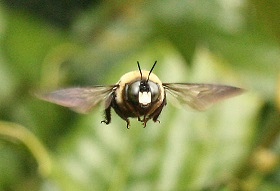Form and Function
 The structures of the Eastern Carpenter Bee help it accomplish many
different functions. This organism has an exoskeleton which acts to
support Xylocopa virginica and provides a site
for muscle attachment. The muscle attachment sites on the
exoskeleton aid X. virginica
with flight, which allows them to gather nectar that will feed
members of the nest. It also allows for jointed legs which permits
easy movement throughout the nest (Encyclopedia of Life 2013). To
check out another interesting organism with an exoskeleton click
here. This link with take you to the Predaceous Diving Beetle, also known
as the Dytiscus dauricus. Next, interestingly enough, the presence of a stinger
is a trait that is only found in females (Missouri Department of
Conservation 2013). Another structure is the mandible which allows X.
virginica to burrow through the wood and make their nest
(Encyclopedia of Life 2013). Lastly, the proboscis helps them steal nectar from flowers or fruits, most commonly from
Rabbiteye Blueberry Plant (Sampson et al. 2004, Adler and Irwin
2006). Click
here to get more information regarding the structures of the
Eastern Carpenter Bee.
The structures of the Eastern Carpenter Bee help it accomplish many
different functions. This organism has an exoskeleton which acts to
support Xylocopa virginica and provides a site
for muscle attachment. The muscle attachment sites on the
exoskeleton aid X. virginica
with flight, which allows them to gather nectar that will feed
members of the nest. It also allows for jointed legs which permits
easy movement throughout the nest (Encyclopedia of Life 2013). To
check out another interesting organism with an exoskeleton click
here. This link with take you to the Predaceous Diving Beetle, also known
as the Dytiscus dauricus. Next, interestingly enough, the presence of a stinger
is a trait that is only found in females (Missouri Department of
Conservation 2013). Another structure is the mandible which allows X.
virginica to burrow through the wood and make their nest
(Encyclopedia of Life 2013). Lastly, the proboscis helps them steal nectar from flowers or fruits, most commonly from
Rabbiteye Blueberry Plant (Sampson et al. 2004, Adler and Irwin
2006). Click
here to get more information regarding the structures of the
Eastern Carpenter Bee.
X. virginica has adapted the
ability to recognize their nestmates. This adaptation is truly
remarkable as they can recall their nestmates in as little as 24
hours (Peso and Richards 2010). The ability to recognize nestmates
is advantageous to both males and females.
The dominant females benefit from
this recognition because it allows for only a few females in the
nest. In this species, only the dominant female is in charge of
reproduction and cares for the young. This makes non-reproductive
females in the nest unproductive, serving no purpose to benefit
other members of the nest. The dominant females will only allow
their
sisters to overwinter in the nest with them (Peso and Richards
2010). The process of overwintering means that the males and females
stay in that nest over the winter and return to that same nest the
following year (Gerling and Hermann 1978). For this reason, the
dominant female must be able to recognize her sisters the next year
to exclude any non-sisters from living in the nest and using all the
resources. (Peso and Richards 2010).
species, only the dominant female is in charge of
reproduction and cares for the young. This makes non-reproductive
females in the nest unproductive, serving no purpose to benefit
other members of the nest. The dominant females will only allow
their
sisters to overwinter in the nest with them (Peso and Richards
2010). The process of overwintering means that the males and females
stay in that nest over the winter and return to that same nest the
following year (Gerling and Hermann 1978). For this reason, the
dominant female must be able to recognize her sisters the next year
to exclude any non-sisters from living in the nest and using all the
resources. (Peso and Richards 2010).
Due to the fact that males are in charge of
protecting the nest, nestmate recognition is also very beneficial to
them. It is important to be able to distinguish nestmates and
non-nestmates. This allows for males to focus their energy on
fending off male non-nestmates who are competing for the dominant
female (Peso and Richards 2010).
Within the nest, aggression between
males is present, however, quickly diminishes once the roles of each
male bee has been set. Two types of males have been found to occupy
a nest, including resident males and satellite males. The resident
male is found above the nest and is considered to be the dominant
male (Prager and Richardson 2012). Dominant males are characterized
as having larger bodies and head sizes. These
features may help make these males more attractive when the dominant
female considers a mate in the process of sexual selection (Barthell
et al. 2006). In contrast, satellite males are positioned around the
sides of the nest (Prager and Richardson 2012). These males have smaller
bodies which may hinder them during sexual selection (Barthell et
al. 2006). After these roles are established, both the
satellite and resident males maintain their status and rarely change
from these roles (Prager and Richardson 2012). By stabilizing roles,
fighting between the nestmate males will occur less often. This will
increase the fitness of both the satellite and resident males, as
they can now use their energy towards attacking male non-nestmates.
This occurrence is known as the dear enemy effect (Barrows 1983,
Peso and Richards 2010).
Continue to
Reproduction
Return to
Home
Go to
References